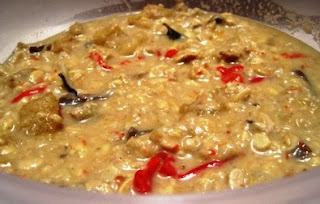Last August 17th, Indonesia celebrated it’s 65th anniversary. The formal celebrations include military marches, military bands playing and hoisting the Indonesian national flag.
The celebration of the Indonesian Independence Day is usually observed by people of different ages, genders, status social economics and regions. They do many creative and unique games like sack races,
kerupuk-eating competition (kerupuk is traditional crackers made of flour),
pinang-climbing (pinang is tree of areca nut),
tug-of-war, recycle creativity, etc. In every province, the races were made based on their own traditional games.
Therefore, Indonesian people are waiting for and preparing to celebrate the Independence Day each year. No matter how old the games, how many people join the games, or how heavy the traffic jams are.
This year, the Independence day fell during fasting month (Ramadan) hence the celebration was not as crowded and full of excitement as in the previous years.
Although I was not fasting, I decided to stay at home and instead of watching traditional games, I cooked one of the Indonesian traditional dishes from East Java region to celebrate this year Independence Day.
Why East Java?
My mother was born in a small town in East Java and since I was a kid, I had been exposed to different typical dishes from East Java. The dish which came to my mind was Sambal Tumpang which my Mom often cooked for me but I have never tried to cook it.
‘Sambal’ means sauce or relish and ‘tumpang’ literally means join with others. This sauce is made of fermented tempeh (soy bean cake), chilies, spices and coconut milk and served on top of boiled vegetables like salad dressing – probably that’s why it’s called ‘sambal tumpang’ coz the sauce joins with others (vegetables).
In my recipes collection I have around 4 different versions of ”Sambal Tumpang’ recipes but I like my Mom’s recipe the most. So on Independence Day I tried out my Mom’s old recipe of Sambal Tumpang.
Ingredients
- Mix of boiled vegetables e.g. string beans, white cabbage, spinach etc
- 200 g Tempeh (fermented soybeans), a bit over-fermented tempeh would be better, sliced into medium chunks. For those who live outside Indonesia (or Asia), you can find tempeh in China town.
- 100 gram of beef (any part of the beef will do because this is just to give more flavor to the sauce) – this is optional. If without the beef this dish is suitable for vegetarian.
- 1 salam leaves
- 2 kaffir lime leaves
- 2 slices galangal root, crushed
- 200 ml coconut milk
- 5 bird eye chilies (only if you want it to be really hot)
- 5 red finger-length chilies
- 2 cloves garlic
- 5 shallots
- 1 cm of Kencur (lesser galangal or Kaempferia galangal)
- Pinch of salt
- Pinch of brown sugar
- 500 ml water
- Optional: some ’Kerupuk Rambak’ (deep fried of the thick skin of cow or buffalo) which looks like this:
This ‘kerupuk rambak’ is quite common in Indonesia but for non Indonesian, this probably can be grouped into Andrew Zimmen’s bizzare food .
How to cook:
- Boil water in a sauce pan
- Add tempeh, the beef meat, shallots, garlic, salam leaves, kaffir lime leaves, galangal, lesser galangal, and the chilies.
- When the meat become tender, remove from the pan. Cut it into smaller pieces. Put it back into the pan. Turn off the heat.
- In a mortar, pound the tempeh, chilies, shallots, garlic, and kencur (lesser galangal). Put them back into the pan.
- Turn the heat on again at low heat.
- Pour the coconut milk, stir it well.
- Add salt and sugar.
- Cook for another 15 minutes
- Add the ‘kerupuk rambak’ (if used)
- Remove from heat
This is the look of the sauce:
And this is the look of the Sambal Tumpang on top of boiled vegetables:














